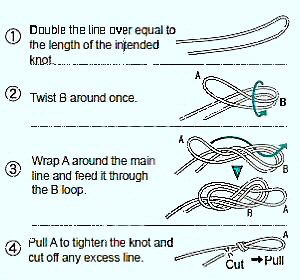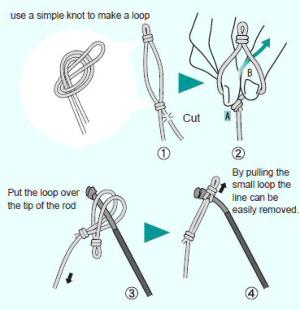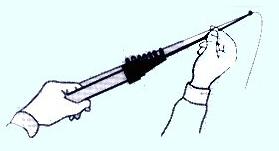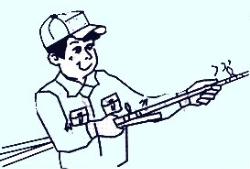Frequently Asked Questions (Help)
Questions About the Site
1. How do I order your product?2. When will you ship my order?
3. Can I have a shipping discount on multiple items?
4. What is your return policy?
5. What is your refund policy?
6. I have more questions, who do I contact?
Questions About Fishing
1. How to Buy a Fishing Rod?2. How to Attach the line to a Fishing Pole?
3. How To Elasticate A Fishing Pole?
4. How To Cast?
5. How To Extend and Insert Telescopic rod?
6. Taking Care of the Rod
7. What to do if sections jammed at a joint?
1. Question: How do I order your product?
Answer: Browse the catalog of all our products until you find the item(s) you require.
Click the "Add to Cart" button to add the product to your shopping cart. The items in your cart are stored now. When you feel you have everything that you need, go to your shopping cart and click on "Check out". You can also click on following link: How to Place an Order and find all the information how to place an order.
2. Question: When will you ship my order?
Answer: Please be patient. Your items will be sent to you by USPS or FedEx carier within 24-48 hours after receiving your payment.
3. Question: Can I have a shipping discount on multiple items?
Answer: Yes, for a multiple items you may have a shippnhg/handling discount. For the shipping charges to be adjusted for multiple item orders please send us an email to request an invoice. Please use our Invoice Request form to provide all necessary information. We will not be able to provide you with an invoice withiout the following information: ship to zip code /postal code; country; item number(s) with quantity for each item. An invoice will be generated and sent within 24 hours to a specified email address.
4. Question: What is your return policy?
Answer:You can return an item during 3 days afer receiving, you have to E-mail: allfishingbuy@gmail.com us your desicion. This offer is contingent on your returning the merchandise in perfect, never used condition, in original packaging, and all parts must be included. If you decide to return the item please ship it to us with signature confirmation and provide us with the tracking number.
5. Question: What is your refund policy?
Answer: If you are not satisfied with the purchase we'll be happy to accept it back and refund you the price of the item. We will not be able to refund the shipping and handling fees, paypal fees we had to pay for the transaction and 15% restocking fees.
The refund is of course contingent on the items being in perfect, never used condition, in original packaging, and all parts must be included.
As soon as We receive and inspect the condition of the merchandise the refund in your name will be posted through the method the payment was received (paypal or check).
6. Question: I have more questions, who do I contact??
Answer: If you have questions that are not covered, you can Contact Us directly.
Back to top
Questions About Fishing
1. Question: How to Buy a Fishing Rod?Answer: When buying a fishing rod as a gift, first of all, you really need to know something about the fishing habits of your intended recipient. Does he fish in freshwater or Saltwater? Does he fish from a boat, a pier, from the bank, or in the surf? Also, what kind of fish does he try to catch? Before buying a rod you need to become familiar with the different compositions and weights of the rod and make a selection based on what you know about the fisherman's needs or preferences.
When making your rod selection, remember the four most important components:
Action - How flexible is the rod?
Power - How stiff is the rod?
Length - How long is the rod?
Material - What is the rod made of?
All these questions must be answered before you can match the correct rod to your fisherman.
For a rod that is easily transportable, and provides flexibility in use, you may be considering the Telescopic Rod. These can adjust from a one foot rod to a 55 foot rod. The graphite and fiberglass composition of these rods make the adjustment a snap. If you are shopping for the fly fisherman, you are looking for fly fishing rod that is slender and flexible and as such, suitable for fishing with flies. You can choose from fiberglass or one of the many graphite composites available. If you're looking for rod to throw small, shallow running crank bait, you need a rod with the proper action and tip that lets you cast accurately. For throwing a big, heavy deep-diver you need power and a rod that'll let you make long casts. Whether it is the smaller freshwater or saltwater game fish, you need to choose an appropriate size for the catch.
You can find more information about selecting the right fishing rod on How to buy a fishing rod page.
2. Question: How to Attach the line to a fishing pole?
Answer:

A single overhand loop on the braid lilian material connected to the pole's tip is all you need.
Next make a double knot on the fishing line.
Next make a double knot on the fishing line.

After that put the loop over the elastic between the pole tip and the single overhand loop and tide the line.
Another way is attaching a Snap Swivel to the elastic that also preventing line twist. Swivel allows quick line change. Rather than cutting and retying, you simply unsnap and re-snap. Also it allows the tackle to spin while keeping your line from twisting.
Back to top
3. Question: How To Elasticate A Fishing Pole?
Answer: Poles do not come ready elasticated. Added to that the task of elastication is a lot easier than it at first sounds and you'll get that satisfaction of knowing that you've done it and with the materials of your choice.
1 Cut off the pole's tip with a small hacksaw. Smooth the edge with sandpaper. Place the bush on the smooth end. Position the bung into the opposite end of the pole so that it fits snugly.
2 Take a pencil and mark around the edge of the pole. Take the snug out of the pole and make a cut along the mark you made.
3 Measure and cut the elastic. Cut it a few inches longer than you need to allow for tying. Insert the elastic through the bung tail's eye. Make one knot and tighten it to feed the tail through the bung. Take the other end of the elastic and insert it through opposite end of the pole and shake the pole so that the elastic goes all the way through.
4 Thread the elastic through the slip connector's sleeve and then through the other part of the connector. Click both parts together, and tie one knot and tighten the elastic. The connector should now be right above the bush.
5 Locate the little collar on the connector and pull it down. Hook your pole rig's loop over the groove, and push the collar back in position.
You can find more information in more details about elasticating fishing pole on
How to elasticate a fishing pole page.
Back to top
4. Question: How To Cast?
Answer: Casting is the act of throwing bait or a lure using a fishing line out over the water using a flexible fishing rod. Remember that perfect casting is performed through wrist action, never use your shoulder or arm to cast.
Casting techniques vary with the type of fishing involved
- Overhand: Hold the rod at 3 o'clock position and pointing towards the target in line with the spot at which you want the lure to land. Bale arm of reel is open and lure is hooked over the pad of the first joint of your index finger. With the bale arm open, support the line on your index finger with the lure about 12 to 18 in below the rod tip.
Lift the rod briskly but smoothly toward the 11-12 o'clock position by raising your forearm and cocking your wrist back. At the start of the lift, the inertia of the rod tip and the weight of the rig will cause the tip to droop. Stop the rod at the 11-12 o'clock position. The tip will straighten and then bend behind you as it is pulled back by the still-travelling lure. You will feel a pull on the rod tip as the lure reaches the limit of its travel.
When you feel the pull on the tip, the rod is under maximum load and storing energy. Immediately punch the rod forward. This punch together with energy released by the rod as it straightens will throw the rig rapidly forward. Stop the movement of the rod at about 3 o'clock position and the same time straighten your index finger to release the line. The rig will shoot forward in an arc towards the water, stripping line from the reel. As the rig falls, follow its descent with the rod tip. When it lands, put your index finger on the spool rim to stop the line, and turn the reel handle to close the bale arm and keep a tight line between the rig and the rod. - Sidearm: Hold the rod parallel to the water's surface facing the target you are going to hit with the lure or bait. Hold and move the rod at a level centralized on your waist. As soon as you flick your wrist, stop for just a second and then release the lure or bait.
- Underhand: With the bale arm open, support the line on your index finger with the lure about 6-8 inches below the rod tip. You want to remain steady while holding the rod at a 45 degree angle which is almost parallel with the water's surface. You should grasp the rod smoothly but use swift action to catapult the line out to the target, while keeping your rod pointed in a downward direction. While you are initiating lure control and raising the tip of the rod when you cast you give your line the added distance as needed.
- Rollcast
- Two-handed Overhand: used to cast the lure or bait the added distances required in many cases to reach feeding inshore fish. In these casts the entire body, rather than just the arms, are utilized to deliver the cast to a long distance
Back to top
5. Question: How To Extend and Insert Telescopic rod?
Answer: Extension of fishing rod with guide

1. Uncover the cap of guide and remove it along a line, otherwise it may break the fishing rod.
2. Drill the fishing line through the bottom guide to the top guide through every guide. Any guide missing drilling may result in breaking the top end.
3. Section by section pull out the fishing rod from top, and screw the joint of two sections till they are tightly fixed.
4. When fully pulling out the rod, align all the guides.
5. After use, loosen the joints in B section and draw in the fishing rod section by section from end.
6. If the fishing line is in disorder, don't draw the line forcibly. Dragging too forcibly on any point of the fishing rod may result in the break of fishing rod.
2. Drill the fishing line through the bottom guide to the top guide through every guide. Any guide missing drilling may result in breaking the top end.
3. Section by section pull out the fishing rod from top, and screw the joint of two sections till they are tightly fixed.
4. When fully pulling out the rod, align all the guides.
5. After use, loosen the joints in B section and draw in the fishing rod section by section from end.
6. If the fishing line is in disorder, don't draw the line forcibly. Dragging too forcibly on any point of the fishing rod may result in the break of fishing rod.
Insertion of fishing rod with guide

1. Insert the end section into the second section, the second section into the third section, and into B section, etc., screw the joint of two sections till they are tightly fixed.
2. Fix the fishing line reel, pull out the line and drill it from bottom guide to the top guide.
3. After use, loosen the joints in B section and draw in the fishing rod section by section from end.
4. To avoid becoming flexible, there is a 4-5mm gap between every connection. Please don't forcibly insert the section.
2. Fix the fishing line reel, pull out the line and drill it from bottom guide to the top guide.
3. After use, loosen the joints in B section and draw in the fishing rod section by section from end.
4. To avoid becoming flexible, there is a 4-5mm gap between every connection. Please don't forcibly insert the section.
Extension and Insertion of fishing rod without guide
1. Take off the plug on fishing rod, pull out the top a little.
2. Pull out the rod section by section, and screw the joint of two sections till they are tightly fixed.

1. After use, loosen the joints in B section and draw in the fishing rod section by section from end.
2. Attention should be paid when drawing in to avoid pulling too forcibly, which may hurt your hand.
3. Draw in the fishing rod from B section by turns. If in reverse, the end section may fall into other sections, and maybe cause damage to fishing rod.
2. Attention should be paid when drawing in to avoid pulling too forcibly, which may hurt your hand.
3. Draw in the fishing rod from B section by turns. If in reverse, the end section may fall into other sections, and maybe cause damage to fishing rod.
Pay attention
1. When draw in the fishing rod after use, loosen the joints by holding the two sides of joint and pull out while screwing, and draw in by turns.
2. Remove the cap of guide along a line, otherwise it may break the fishing rod if screwing too forcibly. Bending the fishing rod too forcibly or using fishing line when it is in disorder may cause break of fishing rod.
Back to top
6. Question: Taking Care of the Rod
Answer: Rod maintenance has nothing to do with rod breakage. Anglers will always find ways to break their rods, starting from regular (car doors) to very stupid (standing on it) or while fighting a huge fish. What should or should not be done to keep our fishing tackle in good shape and ensure many years of fishing enjoyment?
- Always pay attention when fishing under high voltage wire because of electrical shock potentiality by high voltage wire and thunder. Carbon fiber is high electricity-conductive material, so it is very dangerous if it touches electrical wire.
- Don't remain the fishing rod in the back carriage of car too long time. The long time sealed and high temperature condition is harmful for fishing rod.
- Be extra careful when getting your fishing rod out of the car, especially if it is a graphite rod. Too many people break their rod on the car door.
- All rods, particularly graphite rods, are at risk of breakage if the rod is "high sticked". When the tip of the rod is raised too high, the weaker tip section bears too much of the load and can easily break. This is one of the most common causes of breakage and is 100% angler-caused.
- Never store a rod in its tube. Humidity can cause the corrosion of the guide rings.
- Only use the rod with line (and lures) that fall within the limits specified by the blank manufacturer. Using heavier line and cranking down the drag may easily result in unexpected rod breakage, particularly with graphite rods which are less tolerant of abuse than fiberglass.
- Always remember your rod's power rating and don't use fishing lure or line that is too heavy.
- Avoid at all times to knock the rod against hard surfaces. Small scratches and nicks may cause rod breakage.
- Use care when placing or removing rods from storage compartments so as not to catch the guides on the way in or out. Many a guide has been damaged or destroyed by carelessly placing and removing rods from storage compartments.
- Never put a rod wet with salt water back in its case, as you will taint it with salt. If this cannot be avoided for transport reasons, wash it with fresh water as soon as possible.
- After fishing, rinse your rod and dry it with a soft cloth before putting it back into the sheath.
- Inspect the rod rings with a magnifying glass or slip a wad of cotton through them as often as possible. Any small scratches will hold some cotton (they damage the line that goes through the ring). These rings should be replaced.
- Always rub off the moisture, salt and dirt on fishing rod and keep it in a ventilated place.

- The frame of any guide may begin to rust over time if exposed to salt water and not properly cleaned after each use.
- Wet the rod grip and sandpaper thoroughly. Apply soap on the sandpaper and gently rub the grip. Be careful not to scratch the rod itself or the reel seat. Wash, let dry and check the result.
- Small holes can be filled with natural coloured wood putty or with a mixture of cork filings and woodglue.
- Check if no water seeps under the wrappings and corrode the guide ring legs. If rusted, the ring should be replaced.
- Once the rod is clean and dry, spray it with plastic renovator or furnishing spray. You can apply a very light coating of fine oil on the reel seat.
- The best way to store a rod over long periods is to hang it in its case on a pin or clothes hanger inside a wardrobe.
- Periodically, wax your rod with a good quality car wax. This will make it easier to clean and help preserve the rod's finish. Wiping the rod down with furniture polish (such as Pledge) after each use is a good way to keep it looking its best.
A telescoping fishing rod that fits easily in a suitcase or trunk would be great for the traveler who enjoys fishing.
Back to top
7. Question: What to do if sections jammed at a joint?
Answer: The most frustrating things (after braking) that can happen to a telescopic fishing rod is to become jammed at a joint. This can happen for many reasons like due to corrosion or dirt/mud/sand in the joint. The main cause of the joints fixed too tightly is extending the rod too forcibly.
Prevention is better than cure: try do not extend the rod too forcibly, try to keep your rod off the ground at all times to avoid dirt getting into the joints. Wipe it clean with a cloth before taking it down so you don't jam dirt into the joint. If you've been using it in saltwater give it a quick rinse with freshwater as soon after use as you can. Its a good idea to put a protectant like WD-40, Tackle Guard or a silicon lube on the joints.
There are several techniques to unstick the sucker.
A. When the joints are fixed too tightly, hold the anti-sliding place near joints, screw and press them in reverse direction to loosen the joints. Pay attention not to press too forcibly, which may hurt your hands.
B. Hold the anti-sliding place near rubber seat or rubber wheel near joints, and screw and pull them in reserve direction in order to loosen the joints.
C. Pour hot water on large side of the joint as close to the joint as you can to rapidly expand it. Then after a few seconds try twisting or pushing the small side of the joint back down. Its best if you can do this under a tap where the water starts off cold then gets progressively warmer over a few seconds as this reduces the risk of stress cracks developing in the joint.
D. If the hot water technique fails try the next step up. Do the same as above but put ice on the small side of the joint to shrink it. This is easiest if you get some ice from your freezer place it on a cloth or towel and then wrap that around the rod and hold it while you heat the other side with hot water.
E. Try a penetrating lubricant like WD-40, CRC or Tackle Guard. Leave the joint to soak for an hour or two and then try gently to take the rod down.
F. Stand the rod butt on a hard surface like concrete and hold it above the stuck joint. Gently lift and tap the butt on the ground. This works best if the lower joints are stuck. Never tap the tip on the ground as you are very likely to break it.
G.For the poles - rods without guide - Remove the plug of B section, pull out the fixed two sections. Then put the rod vertically on a not-too-hard plain ground (or put towel or other soft material on the ground), hold the fixed joints and knock the ground.
H. Have a partner hold one side of the joint while you hold the other and twist.
Z. If nothing helped buy another rod from our website and take more care of your fishing gear in the future!
Back to top


































